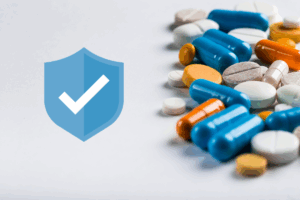National CooperativeRx constantly monitors the pharmaceutical pipeline. As treatment options change, it’s important to know how those changes could impact your plan and which drugs bring the highest value. Our quarterly NCRx Pipeline Reports highlight some of the newest therapies coming to market and are not intended to imply formulary placement or coverage by CVS Caremark.
New Oral Psoriasis Drug Likely to Disrupt the Non-Biologic Market This Fall
Deucravacitinib: A highly anticipated competitor for Otezla® could be arriving in September, if all goes well for Bristol Myers Squibb (BMS) with the U.S. Food and Drug Administration (FDA). Currently, Otezla® is the only oral treatment approved in the full range of mild to severe psoriasis. Clinical trial data puts deucravacitinib between Otezla® and the biologics in terms of efficacy as it led to clear or almost clear skin in about 54% of users within 16 weeks in clinical trials, compared to about 32% for Otezla® and 85% for Skyrizi®, a popular biologic.1,2 What’s more encouraging is that the deucravacitinib’s efficacy seems to increase with time, with 77.7% of users achieving clear or almost clear skin by week 60!3 But of course, any hopeful blockbuster drug needs to be effective and safe, so BMS has been carefully crafting the messaging around the safety of deucravacitinib, highlighting the drug’s differences from other psoriasis treatments and assuring the FDA that there were no safety signals (especially malignancy) seen in clinical trials. While it is indeed reassuring that no increased risk of malignancy has been observed thus far, it will be important to continue to monitor as most other immune-modulating treatments for psoriasis have at least a theoretical risk of malignancy. Other side effects seen during clinical trials were mild to moderate and generally of lower incidence than Otezla®. Finally, while the price of this possible blockbuster is not yet known, it’s expected to fall somewhere in between Otezla® ($51,000 per year*) and the biologics (~$80,000 per year*). Additionally, deucravacitinib won’t require a loading dose like the biologics, which can cost an extra $25,000 in the first year. Overall, deucravacitinib is expected to disrupt the psoriasis market by providing a more effective oral treatment option.
Anticipated Launch: September 2022.
Impact: Moderate. Likely high volume, but mostly replacement spend.
Price: Likely between $51,000 per year and $80,000 per year.
Treatment for Inflammatory Esophageal Condition to Bring Relief…and High Costs
Dupixent®(dupilumab): On May 20, 2022 the FDA) approved an added indication for Dupixent® in adults: Eosinophilic esophagitis (EOE), an inflammatory condition of the esophagus which causes difficulty swallowing, heartburn, vomiting, and sometimes choking. The drug has been on the market since 2017 for severe asthma, eczema, and nasal polyps. Until now, the only treatments for EOE have been steroids and acid reducers used off-label and sometimes surgery, so having an effective, FDA-approved treatment is exciting. In clinical trials, EOE symptoms were reduced by about 28%, and about 60% of patients met the pre-specified goal of reduced eosinophils.4 It’s difficult to make a direct comparison between Dupixent® and current treatments, but for reference, one-third of patients on acid reducers and two-thirds of patients on steroids tend to achieve remission5; and in general, most patients in the Dupixent® trials had already failed these treatments and were severely inflamed. The most notable side effects for Dupixent® are eye irritation, upper respiratory infection, and injection site reaction. However, despite the meaningful efficacy and tolerability, the cost is likely to present a major barrier to uptake. In trials, it was determined that Dupixent® will need to be dosed twice as frequently for EOE than for other conditions, meaning the annual cost of treatment will be $88,000*. Thus, Dupixent® should probably be reserved for patients who fail acid reducers and steroids, but encouragingly, there are several additional products in the pipeline for treatment of EOE so we’re likely to see increased competition in this class soon. Dupixent® is a preferred product on the CVS Advanced Control Formulary for other indications but does not yet have prior authorization criteria for EOE.
Anticipated Launch: May 2022.
Impact: Moderate. Low volume but high cost. There are 160,000 people in the United States with EOE.
Price: $88,000 per year.
Gilead Bringing Treatment for Rare but Serious Hepatitis D
(bulevirtide): In November 2021, Gilead applied to the FDA for approval of bulevirtide, which would be the first ever treatment for hepatitis delta (HepD). The drug was given breakthrough therapy and orphan drug designations, and a decision is expected sometime in quarter three of 2022. HepD is the most severe form of viral hepatitis and occurs only in people who also have hepatitis B. Because infections are not tracked by public health departments, the number of people with HepD in the United States is unknown but is thought to be relatively small; most people become infected when traveling to an endemic area. In an ongoing clinical trial, 37% of patients given injectable bulevirtide for 24 weeks achieved a reduction in viral load and improvement in other laboratory tests.6 Additional data will be reported at 48 weeks and again at 144 weeks. Thus far, it appears Gilead is requesting approval for bulevirtide as a standalone treatment and not a cure, but there are studies underway on the use of bulevirtide in combination with another antiviral/immune drug, pegylated interferon alpha, as a possible curative regimen.7 The most frequent adverse effects seen in clinical trials were increased bile in the blood, injection site reactions, and rebound HepD disease after discontinuing bulevirtide. While this new treatment is certainly good news, the cost of the drug is likely to be high. Historically, drugs for rare conditions are priced to be profitable despite being marketed to a small group of people. There are two additional factors that could come into play in this situation. First, there is likely to be a marketing campaign around testing for HepD. It’s possible there are more people living with HepD than is currently thought, which would increase the drug’s target population. Second, as there is already data suggesting potential for a cure, it’s possible the company’s strategy is to sell the drug as a treatment until the curative regimen is available, at which point the price could substantially increase. This essentially gives Gilead two opportunities to profit from this drug.
Anticipated Launch: Third Quarter 2022.
Impact: Low. Low volume but high cost.
Price: Currently unknown.
Hemophilia A Gene Therapy Delayed…Again. Now Expected Mid-2023.
Roctavian (valoctocogene roxaparvovec): The long-anticipated gene therapy for hemophilia A has been delayed once again. According to Biomarin, the drug’s manufacturer, the FDA has requested additional information, though they clarified the FDA is not looking for additional studies. Biomarin is now set to submit their application for approval in September, putting the FDA decision date somewhere around March or April of 2023. Amid these delays, Biomarin has continued to share updated data on the phase one/two and phase three trials. Patients in phase one/two were broken into two groups: high dose and low dose. In January, they shared patients in the phase one/two trial have stayed relatively bleed-free, with an average of 0.7 bleeds per year in the high dose group five years post-infusion and 1.7 bleeds per year in the low dose group four years post-infusion. Everyone in the phase three trial received a high-dose infusion and have an average of 0.7 bleeds per year two years after receiving the therapy.8 This is reassuring data, especially given the expected price tag of $2 to $3 million for the one-time infusion. However, it’s important to note that factor VIII (the clotting factor that is deficient in hemophilia A and that increase after Roctavian) levels fall steadily each year after receiving Roctavian. Phase one/two trials lend some confidence that patients may experience at least five years relatively bleed-free, but it is unknown if or when the factor VIII level will fall low enough to warrant resumption of regular factor VIII replacement therapy. Either way, the return on investment for the drug is likely to be positive overall, assuming it will be approved only in adults with severe hemophilia A.
Anticipated Launch: Second Quarter 2023.
Impact: High. Shift from pharmacy spend (in many cases) to medical.
Price: Expected to be $2 to $3 million for one-time dose.
Other Recent/Pending FDA Approvals
Olumiant (baricitinib)
Indication: Treatment of alopecia areata.
FDA Approval Date: June 13, 2022.
Cost*: 2mg dose costs $30,000 per year. 4mg dose is not priced yet.
Comments:
- Autoimmune disease causing hair loss.
- First drug approved for indication.
- Roughly 1/3 of patients with at least 80% scalp hair coverage at 36 weeks.9
Dupixent (dupilumab)
Indication: Treatment of eczema in ages six months to five years.
FDA Approval Date: June 7, 2022.
Cost*: $22,000 per year.
Comments:
- Used when topical steroids are not effective.
- 70% improvement in Dupixent group vs. 20% in placebo group.10
- Dupixent is a preferred product on CVS Advanced Control Specialty Formulary.
Skyrizi (risankizumab)
Indication: Chron’s disease.
FDA Approval Date: July 17, 2022.
Cost*: Currently unknown. Cost of psoriasis dosing is $110,000 for the first year and $91,000 per year thereafter. Chron’s dosing will be higher.
Comments:
- Drug already in use for psoriasis.
- Intestinal inflammation resolved in 30-40% with Skyrizi vs. 11-12% with placebo.11
- Fewer treatment options for Chron’s than other autoimmune diseases.
beti-cel
Indication: Treatment of beta thalassemia.
FDA Approval Date: Expected August 16, 2022.
Cost*: Potentially $2.1 million.
Comments:
- Gene therapy for rare condition.
- Backed unanimously by FDA advisory committees.
- Only other treatment for the disease is a blood transfusion.
eli-cel
Indication: Treatment of cerebral adrenoleukodystrophy.
FDA Approval Date: Expected September 16, 2022.
Cost*: Currently unknown.
Comments:
- Gene therapy for rare condition.
- Backed unanimously by FDA advisory committees.
- Only other treatment for the disease is a stem cell transplant.
- Cancer concerns for eli-cel in Europe as it is not approved there.
Radicava (edaravone)
Indication: Oral suspension for Lou Gehrig’s disease.
FDA Approval Date: May 12, 2022.
Cost*: $165,000 per year.
Comments:
- Currently not available as IV given 10 days per month.
- Approximately 33% slower loss of function on Radicava vs. placebo.12
- CVS likely to make oral option available to patients via Specialty Guideline Management process.
Flovent (fluticasone inhalation) authorized generic
Indication: Treatment of asthma.
FDA Approval Date: June 8, 2022.
Cost*: $178 vs. $274 for brand.
Comments:
- Authorized generic identical to the brand and produced by or via contract with brand company.
- Second generic expected later this year.
Breo Ellipta (fluticasone and vilanterol)
Indication: Treatment of chronic obstructive pulmonary disease and asthma.
FDA Approval Date: June 8, 2022.
Cost*: $249 vs. $384 for brand.
Comments:
- Authorized generic identical to the brand and produced by or via contract with brand company.
- No additional Breo generics expected in the near future.
*Wholesale acquisition cost
- Armstrong A, Gooderham M, Warren RB, et al. Efficacy and safety of deucravacitinib, an oral, selective tyrosine kinase 2 (TYK2) inhibitor, compared with placebo and apremilast in moderate to severe plaque psoriasis: Results from the phase 3 POETYK PSO-1 study. Presented at annual scientific meeting of the American College of Rheumatology; November 5-9, 2020.
- Gordon KB, Strober B, Lebwohl M, et al. Efficacy and safety of risankizumab in moderate-to-severe plaque psoriasis (UltIMMa-1 and UltIMMa-2): results from two double-blind, randomised, placebo-controlled and ustekinumab-controlled phase 3 trials. Lancet 2018 Aug 25;392(10148):650-661.
- New Two-Year Deucravacitinib Data Reinforce Durable Efficacy and Consistent Safety Profile in Treatment of Moderate to Severe Plaque Psoriasis. 2022. Available at https://news.bms.com/news/details/2022/New-Two-Year-Deucravacitinib-Data-Reinforce-Durable-Efficacy-and-Consistent-Safety-Profile-in-Treatment-of-Moderate-to-Severe-Plaque-Psoriasis/default.aspx. Accessed June 12, 2022.
- Dupixent prescribing information. Regeneron, Sanofi, Genzyme; 2022. https://www.regeneron.com/downloads/dupixent_fpi.pdf. Accessed June 14, 2022.
- IPD Analytics. June 2022. Rx Brief: Dupixent (Dupilumab) approved for eosinophilic esophagitis.
- Wedenmeyer H, Aleman S, Andreone P, et al. Bulevirtide monotherapy at low and high dose in patients with chronic hepatitis delta: 24 weeks interim data of the phase 3 MYR301 study. Dig Liv Dis Mar 2022; 54(1): S24-25.
- Wedemeyer H. GS-13. Presented at: International Liver Congress; April 10-14, 2019; Vienna, Austria.
- BioMarin Announces Stable and Durable Annualized Bleed Control in the Largest Phase 3 Gene Therapy Study in Adults with Severe Hemophilia A; 134-Participant Study Met All Primary and Secondary Efficacy Endpoints at Two Year Analysis. Available at https://investors.biomarin.com/2022-01-09-BioMarin-Announces-Stable-and-Durable-Annualized-Bleed-Control-in-the-Largest-Phase-3-Gene-Therapy-Study-in-Adults-with-Severe-Hemophilia-A-134-Participant-Study-Met-All-Primary-and-Secondary-Efficacy-Endpoints-at-Two-Year-Analysis?printable=1. Accessed June 17, 2022.
- Prescribing Information. 2022. Lilly USA, LLC.
- Dupixent® (dupilumab) pivotal trial meets all primary and secondary endpoints becoming first biologic medicine to significantly reduce signs and symptoms or moderate-to-severe atopic dermatitis in children as young as 6 months. August 30, 2021. Available at Dupixent® (dupilumab) Pivotal Trial Meets All Primary and Secondary Endpoints Becoming First Biologic Medicine to Significantly Reduce Signs and Symptoms of Moderate-to-severe Atopic Dermatitis in Children as Young as 6 Months | Regeneron Pharmaceuticals Inc. Accessed June 17, 2022.
- D’Haens G, Panaccione R, Baert F, et al. Risankizumab as induction therapy for Crohn’s disease: results from the phase 3 ADVANCE and MOTIVATE induction trials. Lancet May 2022; 399(10340: 2015-2030.
- Prescribing Information. 2022. Mitsubishi.




